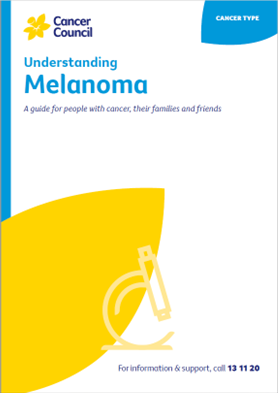- Home
- Melanoma
- Life after melanoma
- Understanding sun protection
Understanding sun protection
After a melanoma diagnosis, you need to take special care to protect your skin from the sun’s UV radiation. This will reduce your risk of further melanomas.
The UV Index shows the intensity of the sun’s UV radiation. It can help you work out when to use sun protection. An index of 3 or above means that UV levels are high enough to damage unprotected skin, and you need to use more than one type of sun protection. The recommended daily sun protection times (see Protecting your skin) are the times of day the UV levels are expected to be 3 or higher. These will vary according to where you live and the time of year.
Sun exposure and vitamin D
UV radiation from the sun causes skin cancer, but it is also the best source of vitamin D. People need vitamin D to develop and maintain strong, healthy bones. The body can absorb only a set amount of vitamin D at a time. Most people get enough vitamin D through incidental exposure to the sun, while using sun protection. When the UV Index is 3 or above, this may mean spending just a few minutes outdoors on most days of the week, depending on where in Australia you live and the time of year.
After a diagnosis of melanoma, talk to your doctor about the best ways to get enough vitamin D while reducing your risk of getting more melanomas. Your doctor may advise you to limit your sun exposure as much as possible when the UV Index is 3 or above. In some cases, this may mean you don’t get enough sun exposure to maintain your vitamin D levels. Your doctor may advise you to take a supplement.
→ READ MORE: If melanoma returns
More resources
Prof H Peter Soyer, Chair in Dermatology and Director, Dermatology Research Centre, The University of Queensland, Diamantina Institute, and Consultant, Dermatology Department, Princess Alexandra Hospital, QLD; A/Prof Matteo Carlino, Medical Oncologist, Blacktown and Westmead Hospitals, Melanoma Institute Australia and The University of Sydney, NSW; Prof Anne Cust, Deputy Director, The Daffodil Centre, The University of Sydney and Cancer Council NSW, Chair, National Skin Cancer Committee, Cancer Council and faculty member, Melanoma Institute Australia; Prof Diona Damian, Dermatologist, Head of Department, Dermatology, The University of Sydney at Royal Prince Alfred Hospital, NSW, and Melanoma Institute Australia; A/Prof Paul Fishburn, General Practitioner – Skin Cancer, Norwest Skin Cancer Clinic, NSW and The University of Queensland; Claire Kelly, National Support Manager, and Emma Zurawel, Telehealth Nurse, Melanoma Patients Australia; Prof John Kelly, Consultant Dermatologist, Victorian Melanoma Service, The Alfred Melbourne and Monash University, VIC; Liz King, Manager, Skin Cancer Prevention Unit, Cancer Council NSW; Lee-Ann Lovegrove, Consumer; Lynda McKinley, 13 11 20 Consultant, Cancer Council Queensland; Angelica Miller, Melanoma Community Support Nurse, Melanoma Institute Australia incorporating melanomaWA, and Cancer Wellness Centre, WA; Dr Amelia Smit, Research Fellow, Melanoma and Skin Cancer, The Daffodil Centre, The University of Sydney and Cancer Council NSW; Prof Andrew Spillane, Professor of Surgical Oncology, The University of Sydney, The Mater and Royal North Shore Hospitals, NSW, and Melanoma Institute Australia; Kylie Tilley, Consumer; A/Prof Tim Wang, Radiation Oncologist, Crown Princess Mary Cancer Centre, Westmead Hospital, NSW. We also thank the health professionals, consumers and editorial teams who have worked on previous editions of this title.
View the Cancer Council NSW editorial policy.
View all publications or call 13 11 20 for free printed copies.

